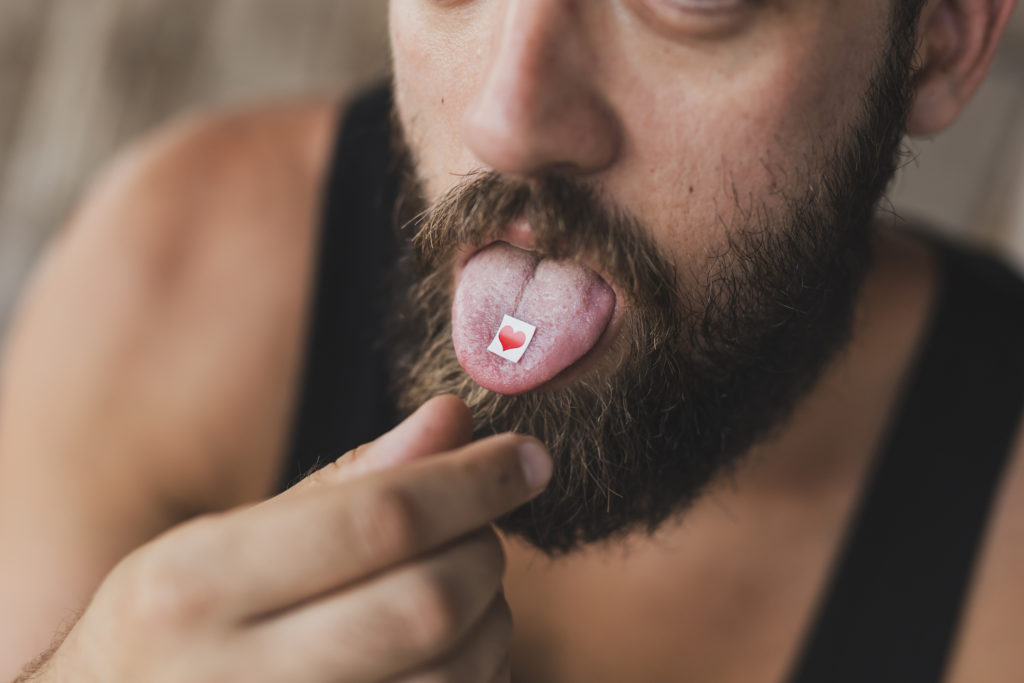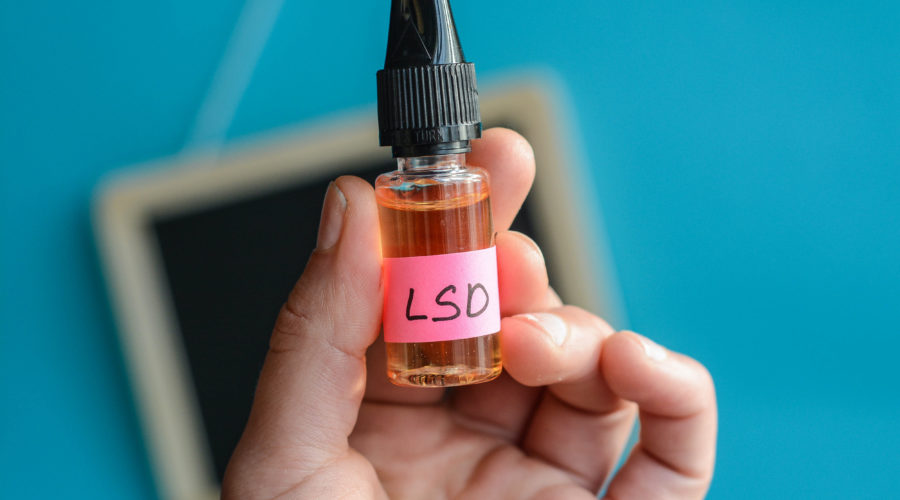What Is LSD (Acid) – Effects, Chemical Structure & More
LSD, also known as “acid,” is a classic psychedelic known for its incredible potency, long-lasting trips, and visual and auditory hallucinations. It was first synthesized in Switzerland in 1938, but its psychedelic properties were not discovered until 1943. That is when chemist Albert Hofmann accidentally dosed himself with the compound in his laboratory.
The drug became popular in North America first among psychiatrists, and then among artists and young people before the United States outlawed the drug in 1968.
LSD was studied by scientists and psychiatrists in the 1950s and 1960s for a variety of potential uses, including as a cure for alcoholism and a spark for creativity, after Sandoz Pharmaceuticals began distributing it to psychiatrists at no charge in 1949. At the time, some referred to LSD as a “miracle cure” for alcoholism, including Alcoholics Anonymous founder Bill Wilson.
In the late 1960s, it had a profound influence on arts and culture, and was used widely by anti-war protesters and so-called “hippies.” Its association with anti-establishment causes and organizations had a lot to do with why it was eventually made illegal.
LSD is, arguably, the psychedelic that has been most affected by the stigma perpetuated against hallucinogenic substances at the start of the War on Drugs. This is evidenced in the current psychedelic landscape: despite the well-documented therapeutic potential of LSD, current research on the drug has taken a backseat to the study of psilocybin mushrooms and MDMA (ecstasy).
Despite the campaigns of misinformation against it, it is still a popular recreational drug and has been used by some of the world’s most prolific artists, musicians, inventors, and mathematicians. One could argue it’s become more popular in recent years thanks to the trend of microdosing.
More recent research has shown that it can be helpful for individuals suffering from end-of-life anxiety and depression and anxiety, with some research suggesting it may also affect pain perception.
One study of LSD for end-of-life anxiety found that every single patient enrolled experienced benefits as a result of taking the drug, with no reported lasting negative effects. A separate study found that, when compared to a placebo, LSD helped to reduce pain perception in participants, at doses as low as 20 micrograms.
It has not been approved by the FDA for any medical uses.
This guide intends to provide readers with critical information about LSD, so that, if one decides to use it, they can make that choice from an educated place. The information covered will include:
- The definition of LSD
- The chemical structure of LSD
- Frequently asked questions about LSD
RELATED: Does LSD Have Nootropic Properties? New Three-Part Study Says Yes
What is LSD?
LSD, or lysergic acid diethylamide, is an extremely potent synthetic chemical and psychedelic drug that is made from a substance found in ergot, a fungus that grows on rye and other grains. It is most commonly administered orally via “tabs” of perforated blotter paper, or in liquid form, and can produce trips lasting twelve hours or longer.
Its effects can vary and are dose-dependent, but can consist of visual and auditory hallucinations, changes in mood, alterations in perception of space and time, and more.
What Does LSD Stand For?
The abbreviation LSD comes from the drug’s German chemical name, lyserg säure diethylamid, which translates in English to lysergic acid diethylamide. It was named by Sandoz Pharmaceuticals chemist Albert Hofmann, who first synthesized the drug in 1938.
What Are The Effects Of LSD?
The effects of LSD are largely dose dependent. Microdoses of LSD (about 10 micrograms) may affect mood, perception, and thought, but are generally thought to be subperceptual.
LSD doses closer to 100 micrograms can produce hallucinogenic effects, including visual and auditory hallucinations, distortion in perception of space and time, and synesthesia (a phenomenon in which one’s senses trade roles. For example, you might see sounds or hear colours).
Other short-term effects can include reduced appetite, dry mouth, sweating, dizziness, and numbness. A person experiencing a “bad trip” may suffer from panic attacks, anxiety, or paranoia.
Some people who take LSD describe feeling an “afterglow” in the days following an experience with the drug. During this period, they might feel lighter, brighter, and have a more positive outlook.
How Long Does LSD Stay In Your System?
After taking LSD, it can take anywhere from 10 to 30 minutes for the effects to kick in. An LSD experience can last for 12 hours or longer depending on the dose.
A urine test can detect LSD within eight hours of use, and up to two to four days after use. A blood test offers a smaller window of time, generally between six and twelve hours, while larger doses of LSD may be detectable in blood tests up to sixteen hours after use.
Although the use of hair testing is rare, LSD can be detected in a hair follicle drug tests up to six months after use. However, because the drug is taken at such low doses, this method of testing may be unreliable.
RELATED: Is LSD Legal – Everything You Need To Know
Microdosing LSD
While microdosing LSD, many people find that it offers a range of psychological benefits. These include some of the following:
- An increase in positive mood
- More creativity
- Higher productivity
- Happiness and life satisfaction
Additionally, it’s important to understand what the proper LSD dose is for your specific goal while microdosing. With LSD tablets coming in doses of 100 micrograms (mcg) — which allows users to divide tabes into sections — microdoses typically range between 5-20 mcg.
As for evidence of microdosing having mental health benefits, results vary.
In a volunteer study from 2019, participants did claim increases in positive emotions and productivity. However, in terms of sheer scientific research, many studies fail to verify how microdoses of LSD can help alleviate things like stress or anxiety.
Overall, users should not anticipate smaller doses of LSD impacting their lives. Rather, there may be more benefit from taking larger doses in a proper, therapeutic setting — where evidence supports psychedelic therapy‘s effectiveness.

The Chemical Structure Of LSD
What Kind Of Drug Is LSD?
LSD, like psilocybin and DMT, is a classic psychedelic of the tryptamine class. More specifically, it is an ergoline alkaloid combining lysergic acid, derived from ergot, with the ammonia derivative, diethylamine. It interacts with serotonin and dopamine receptors in the central nervous system.
LSD binds to and stimulates 5-HT2A receptors, receptors that are essential in learning and cognition. These receptors respond to chemical messengers that help cells in the brain communicate with one another. It is the stimulation of these receptors by LSD that is thought to play a role in triggering the profound experiences or “trips” the drug is known for.
Is LSD Acidic?
One might assume that given its nickname, LSD is naturally more acidic. However, the science on where LSD stands on the pH scale isn’t clear.
Given that the components of LSD have both alkaline and acidic properties, and that it can be diluted at different concentrations, the pH of LSD likely varies from one formulation to the next.
How Is LSD Made?
LSD is synthesized in a laboratory. LSD is a combination of lysergic acid, the common nucleus of active compounds in the fungus, ergot, and a derivative of ammonia called diethylamine.
The production of LSD precursor lysergic acid requires starting material such as ergotamine tartrate. Ergotamine occurs naturally in the ergot fungus, which is known to infect rye and other grains.
Albert Hofmann first created LSD in his lab when he synthesized lysergic acid and combined it with derivatives of ammonia to create 25 different lysergic acid compounds. The last combination Hofmann created, part lysergic acid and part diethylamine, was modeled after a stimulant called Coramine.
Hofmann was hoping to develop a treatment for respiratory and circulatory issues, but after testing the drug in animals, he found that LSD-25 did not have the effect he was looking for. He wouldn’t discover its hallucinogenic effects for several years.
RELATED: How LSD Affects The Brain
LSD FAQs
Are LSD And Acid The Same Thing?
Acid is simply a slang name for LSD that references the drug’s chemical name, lysergic acid diethylamide.
What Are Other Names For LSD?
LSD is also known as acid (based on its scientific name, lysergic acid diethylamide), blotter (based on the way it is administered — on blotter paper), Lucy (based on the Beatles’ song referencing LSD, Lucy in the Sky with Diamonds), and Alice (based on the Disney film, Alice in Wonderland, which is thought to reference LSD).
When LSD was introduced as a commercially available psychiatric medication by pharmaceutical company Sandoz in 1947, it was named Delysid. LSD’s international non-proprietary name is lysergide. Other less popular “street” names for LSD include Dots, Mellow Yellow, Orange Sunshine, California Sunshine, and Window Pane.
What Does LSD Look Like?
LSD is an odorless, white crystalline substance in its purest form. However, LSD is so potent that it is rarely seen in this form outside a laboratory setting — just micrograms of LSD are required for an intense trip.
The substance is generally diluted into a clear liquid solution, which is then applied to perforated blotter paper or gelatin sheets for administration. The paper or sheets are then torn into square “tabs” and placed on the tongue. It can also be administered sublingually in liquid form.

Is LSD A Stimulant?
LSD is classified as a hallucinogen, but it is known to have stimulating effects, potentially causing increased heart rate, increased blood pressure, and increased body temperature. People who take LSD may feel more alert and experience loss of appetite. They may also experience feelings of euphoria, excitement, anxiety, or fear. LSD is also known to disrupt sleep.
How To Take LSD
LSD is taken orally via “tabs,” pieces of perforated blotter paper that have absorbed a liquid solution containing the drug. Sometimes, the drug is taken in liquid form (many people choose to take it this way when microdosing with LSD).
LSD is measured in micrograms, or millionths of a gram. A normal recreational dose can range from 100 to 150 micrograms. A microdose is generally one-tenth of a standard recreational dose — about 10 micrograms, not exceeding 25 milligrams.
Is LSD Addictive?
Contrary to what the Drug Enforcement Administration has to say about LSD, studies have shown that LSD is not addictive. Further, it does not lead to compulsive use among those who experiment with it. It does not cause physical dependency of any kind.
Repeated short-term use of LSD builds tolerance to the drug very quickly. This reduces its effects and makes it hard to use on an ongoing basis. (This is why microdosing protocols call for several days “off” of LSD.)
Is LSD Dangerous?
Although the media has worked hard over the last fifty years to convince the general public that taking LSD is inherently dangerous, a 2017 Global Drug Survey found that behind magic mushrooms and cannabis, LSD was responsible for the lowest percentage of emergency ward visits, implying that it is quite safe. It is considered one of the least toxic recreational drugs available.
While some people have suffered adverse reactions to LSD, some studies have shown that people who use LSD suffer from lower rates of psychological distress and suicidality than people who don’t.
Can You Overdose On LSD?
Large doses of LSD can lead to frightening experiences and negative symptoms. These include vomiting, strange behavior, and in rare cases, coma.
However, a series of case reports from 2020 found that, even at extreme doses, LSD did not lead to fatal overdose.
An overdose is not to be confused with a “bad trip,” which can be caused by taking too much LSD. A negative experience may involve paranoia, anxiety, confusion, unsettling hallucinations, psychosis, depersonalization, and dissociation.
Can LSD Kill You?
There is currently no data to show that high doses of LSD can lead to death. However, case studies have shown that people who have accidentally taken massive amounts of LSD — in one case, as much as 550 times the average dose — have not died as a result.
In one instance, a woman mistakenly took 1,100 micrograms of the drug (about 10 times the average dose). Following the experience, she claims that the mental health issues she’d experienced for most of her life were gone.
In another case, one woman accidentally snorted a whopping 55 milligrams of crystalline LSD, believing it was cocaine. Although she became nauseous and fell into a brief coma, she did not experience any long-term negative side effects. In fact, she said after the accidental dose, the chronic foot pain she suffered from had been cured.
Does LSD Show Up On A Drug Test?
LSD can show up on a drug screening test using urine, blood, and hair samples. However, it does not show up in tests using saliva samples. Metabolic factors like age, genetics, health, and weight may affect how LSD appears in urine, blood, and hair samples.



